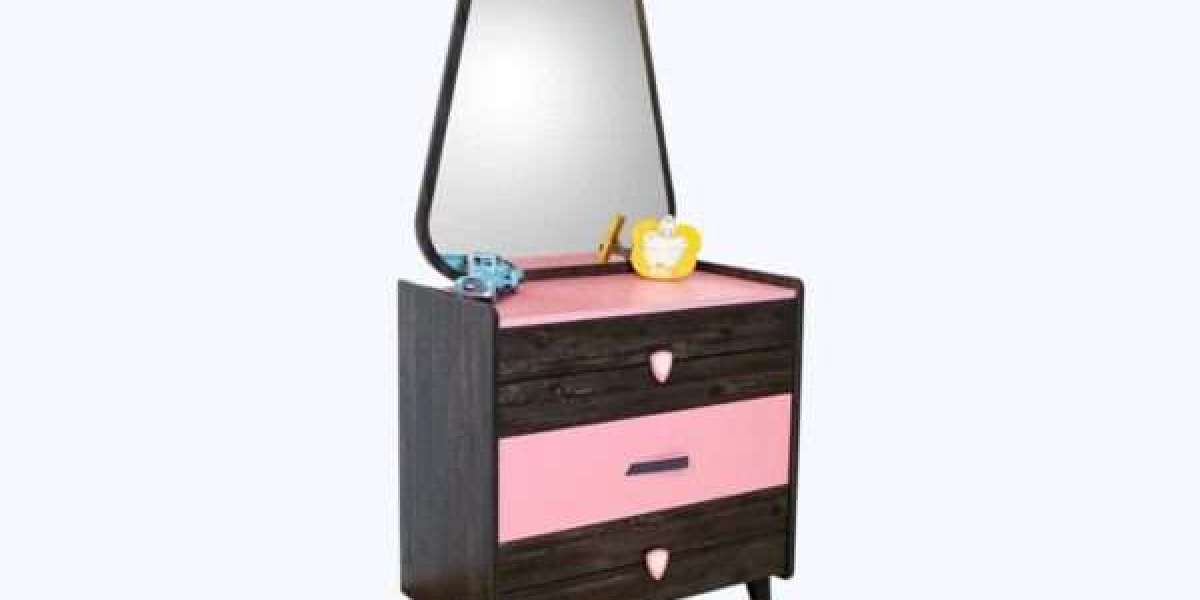A kids dressing table is more than just a piece of furniture—it is often a little corner of joy where children keep their favorite accessories, toys, books, or small treasures. Because it is used frequently and often handled with less care than adult furniture, it requires regular maintenance and proper cleaning to ensure it remains both functional and attractive. Parents often overlook this simple household item until it begins to show signs of wear, stains, or clutter. With the right approach, you can keep the dressing table spotless, durable, and safe for your child to use.
Understanding the Material of the Dressing Table
The first step in maintaining a kids dressing table is knowing what it is made of. These tables are commonly crafted from wood, plastic, or a combination of both, and each material requires a slightly different cleaning routine. Wooden tables are prone to scratches and water damage, while plastic ones can collect dust and lose their shine over time. Some may also come with mirrors, fabric stools, or painted surfaces, which need extra care. By identifying the material, parents can choose the best cleaning agents and techniques without causing damage.
Regular Dusting for Longevity
Dust may seem harmless, but when it accumulates, it can dull the appearance of the dressing table and even affect the health of children who suffer from allergies. Regular dusting with a soft microfiber cloth is one of the simplest ways to keep the surface looking fresh. Parents should make this a weekly routine, ensuring that corners, handles, and mirror edges are included. This small habit prevents buildup, preserves the original shine, and reduces the effort required for deeper cleaning sessions later.
Cleaning the Surface Safely
When it comes to wiping the surface, using gentle, non-toxic cleaners is essential. Children often touch, lean on, or play around the table, so harsh chemicals are not recommended. A mild soap solution or a vinegar-water mixture can do wonders for removing smudges, fingerprints, or food stains. After applying the solution with a damp cloth, the surface should be wiped dry immediately to avoid streaks or watermarks. This approach ensures that the dressing table remains hygienic and safe for everyday use.
Maintaining the Mirror
Most kids dressing tables include a mirror, and this component requires its own cleaning routine. Fingerprints, smudges, and dust are common, especially when little ones like to admire themselves or play dress-up. A mixture of water and a small amount of glass cleaner sprayed onto a cloth—not directly onto the mirror—works best to achieve a streak-free finish. It is also important to wipe gently around the edges to prevent moisture from seeping into the backing, which could cause long-term damage. Regular mirror cleaning not only enhances appearance but also gives children a clear reflection.
Preventing Scratches and Damage
Children often use their dressing tables as more than just furniture—they may play, draw, or even climb onto them. This increases the risk of scratches, dents, and stains. To prevent damage, parents can place a protective mat or cover on the table’s surface. Encouraging children to use the table properly and explaining why it should not be used for rough play also makes a difference. Additionally, placing the dressing table in a safe corner away from high-traffic areas reduces the likelihood of accidental bumps or spills.
Organising Items Neatly
One of the most common challenges parents face is keeping the dressing table clutter-free. Children enjoy keeping small toys, hair accessories, or books on top, which can quickly create a messy appearance. Teaching kids to use drawers, storage boxes, or small containers helps maintain order. Encouraging them to tidy up after playing or dressing fosters responsibility and creates a habit of keeping their space neat. An organised dressing table not only looks better but also makes cleaning much easier.
Addressing Stains Quickly
Spills and stains are inevitable when children are involved. Whether it is a spilled juice box, a marker pen, or sticky hands, the quicker a parent addresses the issue, the easier it will be to remove. For wooden tables, blotting with a soft cloth rather than scrubbing prevents damage. For plastic surfaces, warm soapy water often works well. The key is immediate action, as allowing stains to set can make them permanent. By staying attentive, parents can preserve the table’s original finish for years.
Caring for Drawers and Handles
Many kids dressing table come with drawers for storage, which can easily collect dust, crumbs, and forgotten items. Parents should make it a habit to empty and wipe them down at least once a month. Handles and knobs, often touched with sticky fingers, should also be cleaned regularly. A damp cloth followed by drying helps maintain their shine and prevents buildup. This routine not only enhances hygiene but also keeps the furniture functioning smoothly without sticky or jammed drawers.
Seasonal Deep Cleaning
While regular maintenance is important, a seasonal deep clean can help refresh the entire dressing table. This involves removing all items, thoroughly cleaning each surface, polishing wood if applicable, and disinfecting handles and drawers. Mirrors should be cleaned to perfection, and storage spaces reorganised to ensure everything is in its place. Parents can also take this opportunity to check for loose screws, wobbly legs, or chipped paint, addressing minor issues before they become major problems. A deep cleaning session restores the dressing table’s appeal and extends its lifespan significantly.
Teaching Children Good Habits
Maintaining a kids dressing table should not be the sole responsibility of parents. Children can be taught simple routines that help them take pride in their belongings. For instance, they can be encouraged to wipe the surface with a soft cloth after use, put away toys, and avoid eating or drinking at the table. By turning cleaning into a fun activity or rewarding consistency, parents can instill a sense of responsibility. These habits not only keep the furniture clean but also teach valuable life skills about care and organisation.
Choosing the Right Cleaning Products
Not all cleaning products are suitable for children’s furniture. Harsh chemicals may leave harmful residues or cause surfaces to fade. Parents should look for non-toxic, child-safe options that are gentle yet effective. Natural alternatives like vinegar, baking soda, or lemon juice can also work well for certain stains. Reading product labels and testing cleaners on a small hidden area before full application helps avoid unwanted damage. Choosing safe cleaning products ensures both the furniture’s longevity and the child’s well-being.
Conclusion
A kids dressing table plays a special role in a child’s daily routine, offering a space for creativity, learning, and self-expression. With proper maintenance and cleaning, parents can ensure that this piece of furniture remains not only beautiful but also safe and functional. From regular dusting and stain removal to teaching children simple habits, each step contributes to preserving its charm. By investing time in care and organisation, families can enjoy a well-maintained dressing table that continues to brighten up the room and bring joy to their child’s world.



